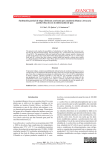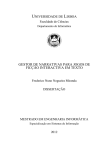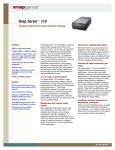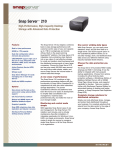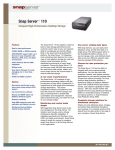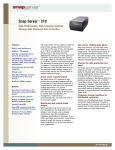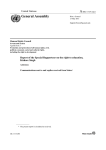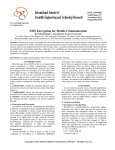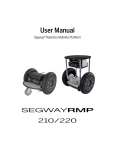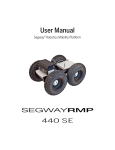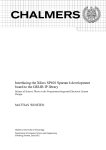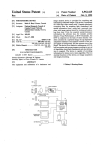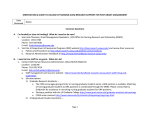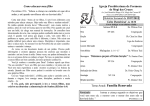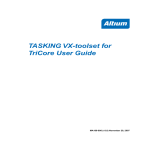Download An On-Chip AMBA AHB Bus Tracer with Dynamic
Transcript
ISSN 2319-8885 Vol.02,Issue.13, October-2013, Pages:1487-1498 www.semargroups.org, www.ijsetr.com An On-Chip AMBA AHB Bus Tracer with Dynamic Compression and Multiresolution for SOC Debugging and Monitoring K.SWATHI1 N. DASHARATH2 PG Scholar, Dept of ECE, Netaji Institute of Engineering and Technology, Hyderabad, A.P-INDIA, Email: [email protected] Asst Prof, Dept of ECE, Netaji Institute of Engineering and Technology, Hyderabad, A.P-INDIA. Abstract: This paper proposes an AMBA AHB on-chip bus tracer named SYS-HMRBT (AHB Multiresolution bus tracer) with dynamic compression and multiresolution for Versatile System-On-Chip (SoC) debugging and monitoring. The ON-CHIP bus is an important system-on-chip (SoC) infrastructure that connects major hardware components. Monitoring the on-chip bus signals is crucial to the SoC debugging and performance analysis/ optimization. The bus tracer is capable of capturing the bus trace with different resolutions, all with efficient built-in compression mechanisms, to meet a wide range of needs The bus tracer adopts three trace compression mechanisms to achieve high trace compression ratio, so that appropriate resolution levels can be applied to different segments of the trace. On the other hand, SYS-HMRBT supports tracing after/before an event triggering, named post-triggering trace/pretriggering trace, respectively. SYS-HMRBT runs at 500 MHz and costs 42 K gates in TSMC 0.13-m technology, indicating that it is capable of real time tracing and is very small in modern SoCs. Experiments show that the bus tracer achieves very good compression ratios of 79%–96%, depending on the selected resolution mode. The SoC has been successfully verified both in field-programmable gate array and a test chip. Keywords: AHB, AMBA, Compression, Multiresolution, Periodical Triggering, Post-T Trace, Pre-T Trace, Real Time Trace, System-On-Chip (Soc) Debugging. I. INTRODUCTION The On-Chip bus is an important system-on-chip (SoC) infrastructure that connects major hardware components. The on-chip bus signals monitoring is very important for the SoC debugging and performance analysis/ optimization. But to monitor such signals is very difficult since they are deeply embedded in a SoC. T here are often no sufficient I/O pins to access these signals. Therefore, we employ a bus tracer embed in SoC to capture the bus signal trace and store the trace in the trace memory which is an on-chip storage, which could then be off loaded to outside world (the trace analyzer software) for analysis. Unfortunately, the size of the bus trace grows rapidly. For ex- ample, to capture AMBA AHB 2.0 [1] bus signals running at 200 MHz, the trace grows at 2 to 3 GB/s. Therefore, it is highly desirable to compress the trace on the fly in order to reduce the trace size. However, simply capturing/compressing bus signals is not sufficient for SoC debugging and analysis. Since the debugging/analysis needs are versatile: some designers need all signals at cycle-level, while some others only care about the transactions. For the latter case, tracing all signals at cycle-level wastes a lot of trace memory. Thus, there must be a way to capture traces at different abstraction levels based on the specific debugging/analysis need. This paper presents a real-time multi-resolution AHB on-chip bus tracer, named SYS-HMRBT (aHb multiresolution bus tracer). The bus tracer adopts three trace compression mechanisms to achieve high trace compression ratio. It supports multi-resolution tracing by capturing traces at different timing and signal abstraction levels. In addition, it provides the dynamic mode change feature to allow users to switch the resolution on-the-fly for different portions of the trace to match specific debugging/analysis needs. Given a trace memory of fixed size, the user can trade off between the granularities and trace length to make the most use of the trace memory. In addition, the bus tracer is capable of tracing signals before/ after the event triggering, named pre-T/post-T tracing, respectively. This feature provides a more flexible tracing to focus on the interesting points. The rest of this paper is organized as follows. Section II surveys the related work. Section III discusses the features in trace granularity and trace direction. SectionIV presents the hardware architecture of our bus tracer. SectionV provides experiments to analyze the compression ratio, trace depth, and cost of our bus tracer. A case study is also conducted to integrate the bus tracer with a 3-D graphics SoC. Finally, Section VI concludes this paper and gives directions for future research. Copyright @ 2013 SEMAR GROUPS TECHNICAL SOCIETY. All rights reserved. K.SWATHI, N. DASHARATH II. RELATED WORK Since the huge trace size limits the trace depth in a trace memory, there are hardware approaches to compress the traces. The approaches can be divided into lossy and lossless trace compression. The lossy trace compression approach achieves high compression ratio by sacrificing the accuracy; the original signals cannot be reconstructed from the trace. The purpose of this approach is to identify if a problem occurs. Anis and Nicolici [2] use the multiple input signature register (MISR) to perform lossy compression. The results are stored in a trace memory and compared with the golden patterns to locate the range of the erroneous signals. The locating needs rerunning the system several times with finer and finer resolution until the size of the search range can fit in the trace memory. Such approach is suitable for deterministic and repeatable system behaviors. However, for a complex SoC with multiple independent IPs, the on-chip bus activities are usually not deterministic and repeat- able. Therefore, lossless compression approaches are more appropriate for real-time on-chip bus tracing. Existing on-chip bus tracers mostly adopt lossless compression approaches. ARM provides the AMBA AHB trace macro- cell (HTM) [3] that is capable of tracing AHB bus signals, including the instruction address, data address, and control signals. The instruction address and control signals are compressed with a slice compression approach (to be explained shortly). On the other hand, the data address is recorded by simply removing the leading zeros. The HTM supports a limited level of trace abstraction by removing bus signals that are in IDLE or BUSY state. The AMBA navigator [4] traces all AHB bus signals without compression. In the bus transfer mode, it also has a limited level of trace abstraction by removing bus signals which are in IDLE, BUSY, or non-ready state. The AHBTRACE in GRLIB IP library [5] captures the AMBA AHB signals in the uncompressed form. In addition, it does not have trace abstraction ability. There are many research works related to the bus signal compression. We characterize the bus signals into three categories: program address, data address/data and control signals. We then review appropriate compression techniques for each category. For program addresses, since they are mostly sequential, a straight forward way is to discard the continuous instruction ad- dresses and retain only the discontinuous ones, so called branch/ target filtering. This approach has been used in some commercial tracers, such as the TC1775 trace module in TriCore [6] and ARM’s Embedded Trace Macrocell (ETM)[7]. The hard- ware overhead of these works is usually small since the filtering mechanism is simple to be implemented in hardware. The effectiveness of these techniques, however, is mainly limited by the average basic block size, which is roughly around four or five instructions per basic block [7], [8]. Other technique such as the slice compression approach [3] targets at the spatial locality of the program address. This approach partitions a binary data into several slices and then records all the slices of the first data and then only part of the slices of the succeeding data that are different from the corresponding slices of the previous one (usually the lower bit positions of the data). For data address/value, the most popular method is the differential approach which records the difference between consecutive data. Since the difference usually could be represented with less number of bits than the original value, the information size is reduced. Hopkins and Mc- Donald–Maier showed that the differential method can reduce the data address and the data value by about 40% and 14%, respectively [9]. For control signals, ARM HTM [3] encodes them with the slice compression approach: the control signal is recorded only when the value changes. As mentioned, compressing all signals at the cycle-ac- curate-level does not always meet the debugging needs. As SoCs become more complex, the transactionlevel debugging becomes increasingly important, since it helps designers focus on the functional behaviors, instead of interpreting complex signals. TABLE I Timing Abstraction Motivated by the related works, our bus tracer combines abstraction and compression techniques in a more aggressive way. The goal is to provide better compression quality and multiple resolution traces to meet the complex SoC debugging needs. For example, our bus tracer can provides traces at cycle-level and transaction-level to support versatile debugging needs. Be- sides, features such as the dynamic mode change and bidirectional traces are also introduced to enhance the debugging flexibility. III. TRACE RESOLUTION AND TRACE DIRECTION The multi resolution trace mode and the pre/post-T tracing are two important features for effective SoC debugging and monitoring. They are discussed in this section in terms of trace granularity and trace direction. A. Trace Multiresolution This section first introduces the definitions of the abstraction level. Then, it discusses the application for each abstraction mode. 1. Timing and Signal Abstraction Definition The abstraction level is in two dimensions: timing abstraction and signal abstraction. At the timing dimension, it has two abstraction levels, which are the cycle level and transaction level, as shown in Table I. The cycle level captures the signals at every cycle. The transaction level International Journal of Scientific Engineering and Technology Research Volume.02, IssueNo.13, October-2013, Pages:1487-1498 AnOn-Chip AMBA AHB Bus Tracer with Dynamic Compression and Multiresolution for SOC Debugging and Monitoring records the signals only when their value changes (event triggering). For example, since the bus read/ write control signals do not change during a successful transfer; the tracer only records this signal at the first and last cycles of that transfer. However, if the signal changes its value cycle-bycycle, the transaction-level trace is similar to the cycle-level trace. At the signal dimension, first, we group the AHB bus signals into four categories: program address, data address/value, access control signals (ACS), and protocol control signals (PCS). Then, we define three abstraction levels for those signals. As shown in Table II, they are full signal level, bus state level, and TABLE II Signal Abstraction size of this mode is huge, the trace depth is the shortest among the five modes. Fortunately, it is acceptable since designers using the cycle-level mode trace only focus on a short critical period. At Mode FT, the tracer traces all signals only when their values are changed. In other words, this mode traces the untimed data transaction on the bus. Comparing to Mode FC, the timing granularity is abstracted. It is useful when designers want to skim the behaviors of all signals instead of looking at them cycle-by-cycle. Another benefit of this mode is that the space can be saved without losing meaningful information. Thus, the trace depth increases. At Mode BC, the tracer uses the BSM, such as NORMAL, IDLE, ERROR, and so on, to represent bus transfer activities in cycle accurate level. Comparing to Mode FC, although this mode still captures the signals cycle-by-cycle, the signal granularity is abstracted. Thus, designers can observe the bus hand- shaking states without analyzing the detail signals. The benefit is that designers can still observe bus states cycle-by-cycle to analyze the system performance. master operation level. The full signal level captures all bus signals. The bus state level further abstracts the PCS by encoding them as states according to the bus-state-machine (BSM). The states represent the bus handshaking activities within a bus transaction. The master state level further abstracts the bus state level by only recording the transfer activities of bus masters and ignoring the handshaking activities within transactions. This level also ignores the signals when the bus state is IDLE, WAIT, and BUSY. Fig.1. Multiresolution traces modes. Combining the abstraction levels in the timing dimension and the signal dimension, we provide five modes in different granularities, as Fig. 1 shows. They are Mode FC (full signal, cycle level), Mode FT (full signal, transaction level), Mode BC (bus state, cycle level), Mode BT (bus state, transaction level), and Mode MT (master state, transaction level). We will discuss the usage of each mode in the following. 2. Applications of Abstraction Modes At Mode FC, the tracer traces all bus signals cycle-by-cycle so that designers can observe the most detailed bus activities. This mode is very useful to diagnose the cause of error by looking at the detail signals. However, since the traced data At Mode BT, the tracer uses bus state to represent bus transfer activities in transaction level. The traced data is abstracted in both timing level and signal level; it is a combination of Mode BC and Mode BT. In this mode, designers can easily understand the bus transactions without analyzing the signals at cycle level. At Mode MT, the tracer only records the master behaviors, such as read, write, or burst transfer. It is the highest abstraction level. This feature is very suitable for analyzing the masters’ transactions. The major difference compared with Mode BT is that this mode does not record the transfer handshaking activities and does not capture signals when the bus state is IDLE, WAIT, and BUSY. Thus, designers can focus on only the masters’ transactions. Please note that there is no mode supporting master operation trace at cycle level, since the intension of observing master behaviors is to realize the whole picture. Tracing master behaviors at cycle level is meaningless and can be re-placed with Mode BC. Multiresolution trace has two advantages for efficient SoC debugging. First, it provides the customized trace for diverse debugging purposes. Depending on the debugging purpose, de- signers can select a preferred abstraction level to observe bus signal variation. For designers debugging at a higher abstraction level, it saves a lot of time analyzing the skeleton of system operations. The idea is to make the hardware debugging process similar to the software debugging process. Designers can use the higher abstraction level trace to obtain the top view and then switch to the lower abstraction level trace on-the-fly to check the detail signals. International Journal of Scientific Engineering and Technology Research Volume.02, IssueNo.13, October-2013, Pages:1487-1498 K.SWATHI, N. DASHARATH It also helps establishing the time line of system behaviors. After, designers switch to the Mode FC to focus on every signal at cycle level for error diagnosis. Please note although the trace size per cycle is huge in this mode, it is usually not necessary to trace a long period. Finally, after Mode FC, designers can switch to Mode BC to see what operations are affected by this bug. Since the behavior at every cycle is worth noticing, this mode preserves the cycle-level trace. However, since designers only care about the behaviors instead of all signals, this mode abstracts the signal level and speeds up the debugging process. Fig.2. Debugging/ monitoring process with dynamic mode change. The trace size varies with the trace modes. Mode FC consumes the largest space. Mode MT consumes the smallest space. Second, the multiresolution tracing saves trace sizes. Since higher-abstraction-level traces capture abstracted data, the required space is smaller. Therefore, given a fixed-size trace memory, the trace depth (cycle) in the higher abstraction level is larger than the traces in the lower abstraction level. 3. Dynamic Mode Change Our bus tracer also supports dynamic mode change (DMC) feature. This feature allows designers to change the trace mode dynamically in real-time. As Fig. 3 shows, the trace mode changes seamlessly during execution. Dynamic mode change has two benefits. One is that it pro- vides customized traces according to the debugging purpose. The other is that designers can make tradeoffs between the trace granularity and the trace depth. Thus, the trace memory utilization is more efficient. Fig. 3 shows an example using dynamic mode change to diagnose a suspected bug. At first, de- signers can use Mode MT to have the top view so that they can skim the master behaviors very quickly. Then, when the time is closed to the suspected bug, they can switch to Mode BT. This provides more information about all operations on the bus and thus, designers can check the detail operations. Fig.4. Illustration of periodical triggering concept. The dynamic mode change is achieved by setting up the event registers. The event registers define the start/stop time of a trace and the trace mode. Thus, when the trigger condition meets and a new trace begins, the new trace starts in the trace mode specified in the event registers. Details are discussed in Section IV. To provide better debugging flexibility, the captured traces can be abstracted into higher abstraction level traces by our trace analyzer software. For example, the traces of mode FC can be abstracted into traces of mode FT, mode BC, mode BT, and mode MT. The traces of mode BC can be abstracted into traces of mode BT and mode MT. This feature increases the debugging flexibility since designers can understand the waveform more quickly in higher abstraction level and narrow down the debugging range in the lower-abstraction-level waveform. A. Trace Direction: Pre-T/Post-T Trace Supporting both trace directions provides the flexible debugging strategies. As Fig.3 shows, the post-T trace captures signals after a triggering event, while the pre-T trace captures signals before the triggering event. The post-T trace is usually used to observe signals after a known event. The pre-T trace is useful for diagnosing the causes of unexpected errors by capturing the signals before the errors. The mechanisms of the pre-T trace and the post-T trace are different. The Post-T trace is simpler since the start time and the stop time are known. It is activated when the Fig.3. Pre-T trace and post-T trace with respect to a matched target event is matched and is turned off when the trace target event. buffer is full. On the other hand, the stop time of the pre-T International Journal of Scientific Engineering and Technology Research Volume.02, IssueNo.13, October-2013, Pages:1487-1498 AnOn-Chip AMBA AHB Bus Tracer with Dynamic Compression and Multiresolution for SOC Debugging and Monitoring trace is unpredictable. The solution is to start tracing as soon as system reset (or some other turning-on event). When the trace buffer is full, the new trace data wrap around the trace buffer, which means the oldest data are sacrificed for the newest ones. Wrapping around the trace buffer causes a problem when the trace needs to be compressed. Typical lossless compression algorithms work by storing some initial (previous) states of the trace first and then calculate the relationship between the current data and the previous states. Since the size of the relationship is smaller than the data size, e.g., the difference, it saves spaces. The initial state of the trace, which is stored at the head of the Fig5. Trace buffer and assistant header position table. (a) The wrapping around does not occur. (b) The wrapping around occurs: the first trace is overwritten by the 17th trace. Fig.6. Event register. first trace is damaged because the initial state is overwritten. Then, the oldest header register is adjusted tent to the second trace. If necessary, more header position registers can be allocated to support more segments in larger buffer. IV. BUS TRACER ARCHITECTURE This section presents the architecture of our bus tracer. We first provide an overview of the architecture for the post-T trace. We then discuss the three major compression methods in this architecture. Finally, we show the extension of the post-T architecture to support the pre-T trace. Post-T Tracer Architecture Overview: Fig.7 is the bus tracer overview. It mainly contains four parts: Event Generation Module, Abstraction Module, Compression Modules, and Packing Module. The Event Generation Module controls the start/stop time, the trace mode, and the trace depth of traces. This information is sent to the following modules. Based on the trace mode, the Abstraction Module abstracts the signals in both timing dimension and signal dimension. The abstracted data are further compressed by the Compression Module to reduce the data size. Finally, the compressed results are packed with proper headers and written to the trace memory by the Packing Module. 1. Event Generation Module: The Event Generation Module decides the starting and stopping of a trace and its trace mode. The module has configurable event registers which specify the triggering events on the bus and a corresponding matching circuit to compare the bus activity with the events specified in the event registers. Optionally, this module can also accept events from external modules. For example, we can connect an AHB bus protocol checker (HPChecker) [12] to the Event Generation Module, as shown in Fig. 8, to capture the bus protocol related trace. Fig. 6 is the format of an event register. It contains four parameters: the trigger conditions, the trace mode, the trace direction, and the trace depth. The trigger conditions can be any combination of the address value, the data value, and the control signal values. Each of the value has a mask field for enabling partial match. For each trigger condition, designers can assign a desired trace mode, e.g., Mode FC, Mode FT, etc., which al- lows the trace mode to be dynamically switched between events. The trace direction determines the pre-T/post-T trace. The trace depth field specifies the length of trace to be captured. 2. Abstraction Module: The Abstraction Module monitors the AMBA bus and selects/filters signals based on the abstraction mode. The bus signals are classified into four groups as mentioned in Section III-A1. Then, depending on the abstraction mode, some signals are ignored, and some signals are reduced to states. Finally, the results are forwarded to the Compression Module for compression. TABLE III COMPRESSION PHASES FOR DIFFERENT SIGNAL TYPES management, and mode change control. For packet management, since the compressed data length and type are variable, every compressed data needs a header for International Journal of Scientific Engineering and Technology Research Volume.02, IssueNo.13, October-2013, Pages:1487-1498 K.SWATHI, N. DASHARATH interpretation. There- fore, this step generates a proper header and attaches it to each compressed datum. In this paper, we call a compressed data with a header as a packet. Since the header generation takes time, to avoid long cycle time, the header generation is implemented in one pipeline stage. For circular buffer management, it man- ages the accesses to the trace memory. Since the size of a packet is variable but the data width of the trace memory is fixed, this module collects the trace data in a first-input, first-output (FIFO) buffer and outputs them to the trace memory until the data size in the FIFO buffer is equal/larger than the data width. If the tracing stops and the data size in the FIFO buffer is smaller than the data width, one additional cycle is required to output the remaining data to the trace memory. When the tracer is in the pre-T trace mode, this module also maintains the header position table mentioned in Section IIIB-II. For mode change control, it manages the insertion of the special packet (called mode-change packet) that distinguishes the current mode from the previous mode. Details are discussed as follows. Fig.7. Multiresolution bus tracer block diagram. Dynamic mode change can be achieved by changing the mode in the abstraction module. Designers can achieve this by setting the desired trace mode in the event register. However, since the header of each packet does not include the mode information because of space reduction, the decompression software cannot tell how to decompress the packets. Therefore, there must be a mode-change packet that indicates the trace mode, placing between two tracers belonging to two different modes. The format Fig.8. Concatenation of mode-change packet for abstraction mode switch. Header 4’b0000 indicates it is a mode change packet. Fig.9. Program addresses compression flow and trace format. International Journal of Scientific Engineering and Technology Research Volume.02, IssueNo.13, October-2013, Pages:1487-1498 AnOn-Chip AMBA AHB Bus Tracer with Dynamic Compression and Multiresolution for SOC Debugging and Monitoring It is very important to insert this packet at the right time. Since the tracer is divided into several pipeline stages, during mode change, there are two trace data belonging to two modes in the pipeline stages. The insertion of the modechange packet must waits until the trace data belonging to the previous mode to be processed. It is achieved by the mode change controller in the Packing Module. It accepts the mode change signal from the Event Generation Module and monitors the Abstraction Module and the Compression Module. When the last-cycle datum of the previous mode is processed and created as a packet, the mode- change packet is inserted into the FIFO with that packet at the same cycle. The reason of writing the two packets at the same time is to avoid pipeline stall due to inserting the mode-change packet, since the pipeline stall will prevent the bus tracer from accepting new input data and cause discontinuous traces. B. Compression Mechanism Although the Abstraction Module can reduce the trace size, the remaining trace volume is still very large. To reduce the size, the data compression approaches are necessary. Since the signal characteristics of the address value, the data value, and the control signals are quite different, we propose different compression approaches for them 1. Program Address Compression We divide the program address compression into three phases for the spatial locality and the temporal locality. Fig.9 shows the compression flow. There are three approaches: branch/ target filter, dictionary-based compression, and slicing. 3. Dictionary-Based Compression To further reduce the size, we take the advantage of the temporal locality. Temporal locality exists since the basic blocks repeat frequently (loop structure), which implies the branch and target addresses after Phase1 repeat frequently. Therefore, we can use the dictionary-based compression. The idea is to map the data to a table keeping frequently appeared data, and record the table index instead of the data to reduce size. Fig. 10 shows the hardware architecture. The dictionary keeps the frequently appeared branch/target addresses. To keep the hardware cost reasonable, the proposed dictionary is implemented with a CAM-based FIFO. When it is full, the new address will replace the address at the first entry of FIFO. For each input datum , the comparator compares the datum with the data in the dictionary (table []). If the datum is not in the table (match= Miss), the datum (uncompressed-data) is written into the table and also recorded in a trace. Otherwise (match=Hit), the index (match-index) of the hit table entry is recorded instead of the datum. The hit index can be further compressed. As we know, a basic block is composed by a target address and a branch address, and the branch instruction address appears right after target instruction address. By the fact that basic blocks repeat frequently, if the target addresses is hit at the table entry i, the branch address will hit at the table entry , since these entries are stored in the dictionary in a FIFO way. Therefore, instead of recording the hit index of that branch address, we create a special header, called the continuous hit, to represent that branch address if it meets this condition. This is the packet format 1 in Fig. 9. 4. Slicing The miss address can also be compressed with the Slicing approach. Because of the spatial locality, the basic blocks are often near each other, which mean the highorder bits of branch/target addresses nearly have no change. Therefore, the concept of the Slicing is to reduce the data size by recording only the different digits of two Fig.10. Block diagram of the dictionary-based compression circuit. 2. Branch/Target Filtering This technique aims at the spatial locality of the program address. Spatial locality exists since the program addresses are sequential mostly. Software programs (in assembly level) are composed by a number of basic blocks and the instructions in each basic block are sequential. Because of these characteristics, Branch/target filtering can records only the first instruction’s address (Target) and the last instruction’s address (Branch) of a basic block. The rest of the instructions are filtered since they are sequential and predictable. Fig.11. Block diagram of the slicing circuit. consecutive miss addresses. To implement this concept in hardware, the address is partitioned into several slices of an equal size. The comparison between two consecutive miss addresses is at the slice level. For example, there are three address sequences: A(0001_0010_0000), B(0001_001 0_0110), C(0001_0110_0110). At first, we record instruction A’s full address. Next, since the upper two International Journal of Scientific Engineering and Technology Research Volume.02, IssueNo.13, October-2013, Pages:1487-1498 K.SWATHI, N. DASHARATH slices of address B are the same as that of the address A, only the least-significant slice is recorded. For address C, since the most significant slice is the same to that of the address B, only the lower two slices are recorded. Fig. 11 shows the hardware architecture. It has the register REG storing the previous data ( ).The slice comparator compares the slices of the current datum ( ) and the previous datum and produces the identical slice number ( ). This in- formation is forwarded to the packing module to generate the proper header. This is the packet format 3 in Fig. 9. Table IV shows an example of the compression approaches in Phases 2 and 3. At time 1, since the address (0x00008020) cannot be found in the dictionary, it is inserted into the dictionary entry 0 and is recorded in a trace. At time 2, the address (0x00008030) is also a miss address and inserted into dictionary entry 1. However, after slicing, since only the lower two slices are different, only the address 0x30 is recorded. At time5, because the address (0x00008020) has been stored in the dictionary entry 0 at time 1, only the index 0x0000 is recorded. At time 6, since the address (0x00008030) also has been stored in the dictionary entry 1, and its index is the previous address plus 1, we do not have to record anything except the header (as the packet format 1 in Fig. 9), which indicates this is a hit address and this meets the continue index condition. 5. Data Address/Value Compression Data address and data value tends to be irregular and random. Therefore, there is no effective compression approach for data address/ value. Considering using minimal hardware resources to achieve a good compression ratio, we use a differential approach based on the subtraction. Fig. 12 shows the bit of the difference value. The differential module calculates the absolute difference value . Since the absolute difference between two data value may TABLE IV Example of Dictionary-Based Compression with Slicing. Third, Fourth, And Fifth Columns Are Packet Headers. Referring To The Three Types Of Packet Format In Fig. 10, Compressed Packets Are In Packet Format 3. Compressed Packets 5 a n d 9 A re In Packet Format 2. Compressed Packet and Are in Packet Format2 be small, we can neglect the leading zeros and use fewer digits to record it. Therefore, the size of module calculates the nonzero digit number of the difference. Finally, the encoded datum is sent to the packing module along with . Fig.13. Data address/value trace compression format means the sign magnitude. Fig.12. Block diagram of differential compression circuit for data address/value compression. For simple hardware implementation, the digit number of an absolute difference is limited to four types, as Fig. 14 shows. The header indicates the data trace format. If the difference is larger than 65535 (216-1), the bus tracer records the uncompressed full 32-bit data value. Otherwise, the bus tracer uses 4-, 8-, or 16-bit length to record the absolute differences, whichever is appropriate. 6. Control Signal Compression We classify the AHB control signals into two groups: access control signals (ACS) and protocol control signals (PCS). ACS is signals about the data access aspect, such as read/write, transfer size, and burst operations. PCS are signals controlling the transfer behavior, such as master International Journal of Scientific Engineering and Technology Research Volume.02, IssueNo.13, October-2013, Pages:1487-1498 hardware compressor. The register REG saves the current datum and outputs the previous datum . By comparing the current datum with the previous data value, the three modules comp, differential, and size of output the encoded results. The comp module computes the sign AnOn-Chip AMBA AHB Bus Tracer with Dynamic Compression and Multiresolution for SOC Debugging and Monitoring request, transfer type, arbitration, and transfer response. Control signals have two characteristics. First, the same combinations of the control signals repeat frequently, while other combinations happen rarely or never happen. The reason is that many combinations do not make sense in a SoC. It depends on the processor architecture, the cache architecture, and the memory type. Therefore, the IPs in a SoC tends to have only a few types of transfer despite the bus protocol allows for many transfer behaviors. Second, control signals change infrequently in a transaction. Because of these two characteristics, ACS/PCS are suitable for dictionary-based compression. The idea is to treat the signals in ACS/PCS as one group. Since the variations of transfer types are not much and transfer types repeat frequently, we can map them to the dictionary with frequently transfer types to re- duce size. For example, the original size of ACS is 15 bits. If we use 3-bit to encode the signal combinations of ACS, we can re- duce trace size by . To simplify the hardware design for cost consideration, this dictionary is also implemented as a FIFO buffer. With this approach, the dictionary adapts itself when the ACS/PCS behaviors change. Please notice that, in full-signal level trace, both ACS and PCS are compressed by the dictionary-based compression without abstraction. In bus-state level trace, the PCS are first abstracted into states by the BSM model and then compressed by the dictionarybased compression. A. Extension of the Post-T Trace Architecture to Support the Pre-T Trace The bus tracer described in Sections IV-A and IV-B is for the post-T trace. We now extend the bus tracer to support the pre-T trace with the technique of periodical triggering. The concept of periodical triggering is to break the relation- ship between the new trace and the previous trace. This can be achieved by resetting the internal data structure for data encoding. For example, the register REG keeping the previous data in the slicing (see Fig. 11) and the differential compressor (see Fig. 12) must be reset. Also, the table in the dictionary-based compression (see Fig. 11) is the same. We use Fig. 14 to illustrate the concept. It is an example showing the periodical triggering of the differential compression. The encoded result (the difference ) is produced by subtracting the previous data | from the current data . For example, the encoded data is 2-5 3 at time T. If the trace mode does not change, the current data is registered for encoding the new data at the next cycle. Otherwise, the flush signal asserts. Then, the register keeping the previous data is reset and a new trace begins. For example, at time T+2, (11) is recorded in the uncompressed format by subtracting 0 from it, which serves as an initial state for the new trace. Please notice that no data is lost during the reset, though the data storage cannot accept new input data while it is reset. For example, the register in Fig. 15 takes 1 cycle (T+2) to reset, during that cycle, the input data ( with value 11) is recorded in uncompressed format. To implement the periodical triggering concept, we add extension hardware to the original tracer, as shown in Fig. 15. The Triggering Module decides the time to start a new trace based on the trace length (a segment size). It asserts the Fig.14. Example of periodical triggering in differential compression TABLE V Specification of the Implemented Sys-HMRBT Bus Tracer TABLE VI Syntheses Results under TSMC 0.13- µ m Technology Fig.15. Extension architecture for supporting post-T trace. Below is the ex- tension to the original bus tracer. International Journal of Scientific Engineering and Technology Research Volume.02, IssueNo.13, October-2013, Pages:1487-1498 K.SWATHI, N. DASHARATH flush signal when a new trace begins. Since the compression module is divided into several pipeline stages, the flush signal is also pipelined to reset each pipeline stage in order. This is necessary since the Compression Module requires several cycles to process the data belonging to the previous trace. D. Integration into SoC To integrate the bus tracer (including the trace memory) into a SoC, we can simply tap the bus tracer to the AHB bus, as shown in Fig. 16. The bus tracer can be controlled with an on-chip processor (option 1) or an external debugging host (option 2). For option 1, the processor configures the bus tracer via a bus slave interface. After the bus tracer compresses and stores the TABLE VII Trace Compression Ratio at Different Trace Modes TABLE VIII Tradeoffs between Trace Mode and Output Pin traces into the trace memory, the processor can read the traces via the bus slave interface of the trace memory. For option 2, the slave interfaces of the bus tracer and the trace memory can also be connected to a test bus. The external debugging host can then access the test bus to control the bus tracer and the trace memory via a test access mechanism, such as IEEE 1500. In order to achieve real time tracing, the bus tracer is pipelined to meet the on-chip bus frequency. Since the trace data processing is stream-based, the bus tracer can be easily divided into more pipeline stages to meet aggressive performance requirements. V. EXPERIMENTAL RESULTS The specification of the implemented SYS-HMRBT bus tracer is shown in Table V. It has been implemented at C, RTL, FPGA, and chip levels. The synthesis result with TSMC 0.13-µm technology is shown in Table VI. The bus tracer costs only about 41 K gates, which is relatively small in a typical SoC. The largest component is the FIFO buffer in the packing module. The second one is the compression module. The cost to support both the pre-T and post-T capabilities (periodical triggering module) is only 1032 gates. The major component of the event generation module is the event register, which is roughly 1500 gates per register. As for the circuit speed, the bus tracer is capable of running at 500 MHz, which is sufficient for most SoC’s with a synthesis approach under 0.13-µm technology. If a faster clock speed is necessary, our bus tracer could be easily partitioned into more pipeline stages due to its streamlined compression/packing processing flow. In the rest of this section, we present the analysis of various system metrics of the bus tracer, such as trace resolution, compression quality, depth, trace memory size, and I/O pin count, etc. A. Analysis of the Trace and Hardware Characteristics To evaluate the effectiveness of our bus tracer, we integrated it with ARM’s EASY (Example AMBA SYstem) SoC plat- form [14]. Five C benchmark programs were executed on this platform. The first 10 000 cycles of AHB signals (a mixture of setup and loop operations) were captured as a post-T trace under FC, FT, BC, BT, and MT trace modes, respectively. The results were shown in Table VII. The average compression ratios of these benchmark programs range from 79% for the most de- tailed mode FC (full signals, cycle-level) to 96% for the most abstract mode MT (master state, transaction-level). In between are the other modes with intermediate levels of abstraction. Fig.16. Example of integrating the bus tracer into a SoC. The high compression ratio achieved by our bus tracer makes it possible to output the trace data to the outside world in real time via output pins. Table VIII shows the required minimal pin count for each trace mode, ranging from 7 to 21. Please note that the pin counts can be shared among different modes. For example, if there is 21 output pins available for the bus tracer, all five modes could be output in real time, whereas three modes (BC, BT, and MT) International Journal of Scientific Engineering and Technology Research Volume.02, IssueNo.13, October-2013, Pages:1487-1498 AnOn-Chip AMBA AHB Bus Tracer with Dynamic Compression and Multiresolution for SOC Debugging and Monitoring could be output in real time when there are 13 pins available. However, with only seven pins, the bus tracer could still output the trace at mode MT in real time. Therefore, our bus tracer allows designers to customize the pin resource and trace resolution for real time trace dumping to match a diverse range of debugging needs. If output pins are not available; we can also store the trace data in an on-chip trace memory. Yang Et Al.: On-Chip AHB Bus Tracer with Real-Time Compression TABLE IX Trace Depth Analysis of Dynamic Mode Change (DMC) In a 2 Kb Trace Memory We further explored the dynamic mode change (DMC) feature of our bus tracer. Table IX estimates the number of cycles that can be captured in each trace mode under four configurations of dynamic mode change in a 2 kb trace memory (base on the information in Table IX). For each configuration, the numbers in parenthesis show the size percentage of the five modes in the trace memory respectively. For example, configuration I captures trace segments under modes FC, FT, BC, BT, and MT, with each mode taking up 10%, 15%, 20%, 25%, and 30% of the trace memory respectively. The resulted depth of each segment is 82, 144, 261, 398, and 736 cycles, respectively. This experiment demonstrates that our bus tracer allows users to dynamically zoom in/out the observation of the bus for different level of details and for different periods of time, and thus it is capable of supporting versatile SoC development/debugging needs, such as module development, chip integration, hardware/software integration and debugging, system behavior monitoring, system performance/power analysis and optimization, etc. Table XI compares the features of our tracer with related AHB bus tracers: ARM’s HTM [3], FS2 AMBA Navigator [4] and LEON3 AHBTRACE [5]. (Since the TC1775 trace module in TriCore [6] and ARM ETM [7], reviewed in Section II, are for processor tracing instead of bus tracing, we do not compare our work with them in the experiment). not supported by HTM. Compared with HTM, our tracer supports all four kinds of signals (Paddr, Daddr, Dvalue, and Ctrl), all with more aggressive compression algorithms. On the other hand, AMBA Navigator and AHBTRACE support all four kinds of signals, but do not provide any compression support. For the trace direction, AMBA Navigator and AHBTRACE support only the post-T traces, while HTM and our tracer sup- port both pre-T and post-T traces. As for the multi-resolution support, HTM and AMBA Navigator have limited abstraction capability in the timing dimension. They filter signals when the bus state is in the IDLE or BUSY cycles. On the other hand, our tracer supports abstraction in both timing and signal dimensions, which provides more versatile debugging/monitoring functionalities and better trace compression ratio. In addition, our tracer allows dynamic mode change, which is a unique feature among all AHB bus tracers. It is not an easy task to conduct quantitative comparison. HTM and AMBA Navigator are commercial products which we do not have access to, and there is no information about their trace quality available in literature. However, based on the qualitative comparison in Table XI, we could reasonably conclude that our tracer supports both more features and better compression quality. On the other hand, the technical information that in order to have a fair comparison, we assume the full buffer utilization for both post-T traces and pre-T traces. For the 1 kb trace memory, the compression ratio of pre-T traces is about 6.71% inferior to that of post-T traces. However, the difference is reduced as the trace memory size increases: only 3.75% for 16 kb trace memory. Practically speaking, the difference (from 3.75% to 6.71%) between the pre-T and post-T traces is not significant in most debugging/monitoring needs. Should such difference matters, the designer should choose a larger trace memory as permitted by the global cost budget to minimize such difference. TABLE XI Comparisons with Related Bus Tracers Of the three related works, ARM’s HTM is the only one which attends to compress traces. It uses the slicing technique to reduce the trace size of the pro- gram address (Paddr) and control signals (Ctrl). On the other hand, the data address (Daddr) trace size is reduced by removing the higher order zeros. However, the data value (Dvalue) trace is International Journal of Scientific Engineering and Technology Research Volume.02, IssueNo.13, October-2013, Pages:1487-1498 K.SWATHI, N. DASHARATH TABLE XII Trace Depth Comparison for Various Configurations of Our Periodical Triggering Approach Des., Autom. Test Eur. Conf., Apr. 16–20, 2007, pp. 1–6. [3] ARM Ltd., San Jose, CA, “ARM. AMBA AHB Trace Macrocell (HTM) technical reference manual ARM DDI 0328D,” 2007. [4] First Silicon Solutions (FS2) Inc., Sunnyvale, CA, “AMBA navigator spec sheet,” 2005. [5] J. Gaisler, E. Catovic, M. Isomaki, K. Glembo, and S. Habinc, “GRLIB IP core user’s manual, gaisler research,” 2009. TABLE XIII Compression Ratio Comparison of Pre-T Traces and Post-T Traces [6] Infineon Technologies, Milipitas, CA, “TC1775 TriCore users manual system units,” 2001. [7] ARM Ltd., San Jose, CA, “Embedded trace macrocell architecture specification,” 2006. [8] E. Rotenberg, S. Bennett, and J. E. Smith, “A trace cache micro architecture and evaluation,” IEEE Trans. Comput., vol. 48, no. 1, pp.111–120, Feb. 1999. VI. CONCLUSION I have presented an on-chip bus tracer SYS-HMRBT for the development, integration, debugging, monitoring, and tuning of AHB-based SoC’s. It is attached to the on-chip AHB bus and is capable of capturing and compressing in real time the bus traces with five modes of resolution. These modes could be dynamically switched while tracing. The bus tracer also supports both directions of traces: pre-T trace (trace before the triggering event) and post-T trace (trace after the triggering event). With the aforementioned features, SYS-HMRBT supports a diverse range of design/de- bugging/monitoring activities, including module development, chip integration, hardware/software integration and debugging, system behavior monitoring, system performance/power anal- ysis and optimization, etc. The users are allowed to tradeoff between trace granularities and trace depth in order to make the most use of the on-chip trace memory or I/O pins. SYS-HMRBT costs only 42 K gates, making it an valuable and economical investment in a typical SoC. It runs at 500 MHz in TSMC 0.13m technology, which satisfies the requirement of real-time tracing. Experiment results show it achieves high compression ratio ranging from 79% to 96% depending on the trace mode. In the future, we would extend this work to more advanced buses/connects such as AXI or OCP. VII. REFERENCES [1] ARM Ltd., San Jose, CA, “AMBA Specification (REV 2.0) ARM IHI0011A,” 1999. [2] E. Anis and N. Nicolici, “Low cost debug architecture using lossy compression for silicon debug,” in Proc. IEEE [9] A. B. T. Hopkins and K. D. Mcdonald-Maier, “Debug support strategy for systems-on-chips with multiple processor cores,” IEEE Trans. Comput., vol. 55, no. 1, pp. 174–184, Feb. 2006. [10] B. Tabara and K. Hashmi, “Transaction-level modeling and debug of SoCs,” presented at the IP SoC Conf., France, 2004. [11] B. Vermeulen, K. Goosen, R. van Steeden, and M. Bennebroek, “Com- munication-centric SoC debug using transactions,” in Proc. 12th IEEE Eur. Test Symp., May 20– 24, 2007, pp. 69–76. [12] Y.-T. Lin, C.-C. Wang, and I.-J. Huang, “AMBA AHB bus protocol checker with efficient debugging mechanism,” in Proc. IEEE Int. Symp.Circuits Syst., Seattle, WA, May 18–21, 2008, pp. 928–931. [13] Y.-T. Lin, W.-C. Shiue, and I.-J. Huang, “A multiresolution AHB bus tracer for read-time compression of forward / backward traces in a circular buffer,” in Proc. Des. Autom. Conf. (DAC), Jul. 2008, pp. 862–865. [14] ARM Ltd., San Jose, CA, “Example AMBA system user guide ARM DUI0092C,” 1999. [15] R. -T Gu, T.-C Yeh, W.-S Hunag, T.-Y. Huang, C.-H Tsai, C.-N Lee, M.-C Chiang, S.-F Hsiao, and I.-J.H YunNan Chang, “A low cost tile-based 3D graphics full pipeline with real-time performance monitoring support for opengl es in consumer electronics,” in Proc. ISCE, Jun.20–23, 2007, pp. 1–6. International Journal of Scientific Engineering and Technology Research Volume.02, IssueNo.13, October-2013, Pages:1487-1498












